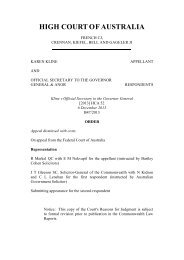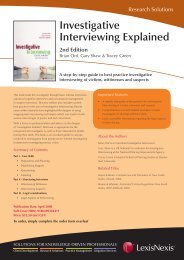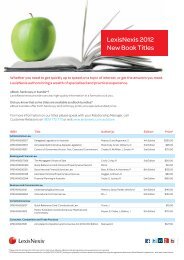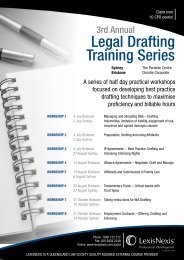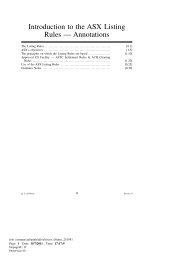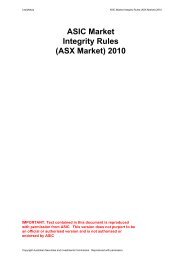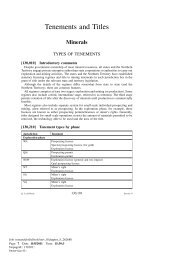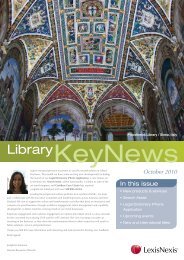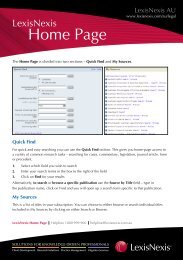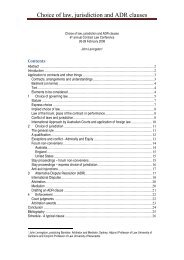Statutory Obligations and Discretions - LexisNexis
Statutory Obligations and Discretions - LexisNexis
Statutory Obligations and Discretions - LexisNexis
You also want an ePaper? Increase the reach of your titles
YUMPU automatically turns print PDFs into web optimized ePapers that Google loves.
CHAPTER 13STATUTORY OBLIGATIONS AND DISCRETIONSGaudron, McHugh, Gummow <strong>and</strong> Callinan JJ unanimously concluded that thesecond interpretation was the correct one.]Gleeson CJ <strong>and</strong> McHugh J [at 152–3]: When a statutory power is conferred bythe use of words of permission, there may arise a question whether the effectis to impose an obligation, or, at least, an obligation that must be performed incertain circumstances. Even where it is plain that the intention of the legislaturewas permissive, questions may arise as to the nature of the considerations thatthe person in whom the power is confided may be entitled or bound to take intoaccount in the exercise of the discretion conferred. Issues of this kind are to beresolved as a matter of statutory interpretation, having regard to the languageof the statute, the context of the relevant provision, <strong>and</strong> the general scope <strong>and</strong>objects of the legislation: Ward v Williams (1955) 92 CLR 496, 505 (Dixon CJ, Webb,Fullagar, Kitto <strong>and</strong> Taylor JJ).As was pointed out in Ward v Williams (at 506) there is a long history oflegislative intervention in New South Wales ‘to restrain the development of the notionthat permissive words may have a compulsive effect’. The current provision is s 9 ofthe Interpretation Act 1987 (NSW) which, except in so far as the contrary intentionappears in an Act or instrument (s 5), provides that the word ‘may’, if used to confer apower, indicates that the power may be exercised or not, at discretion.An example of a statutory provision in which a contrary intention appearedmay be seen in Finance Facilities Pty Ltd v Federal Commissioner of Taxation (1971)127 CLR 106. Section 46(3) of the Income Tax Assessment Act 1936 (Cth) providedthat, if the Commissioner was satisfied that certain conditions as to non-payment ofdividends were fulfilled, the Commissioner ‘may allow’ a private company a rebate inits assessment. This Court held that, if the Commissioner was satisfied of the specifiedcondition, then he was obliged to allow the rebate. The taxpayer had a right orentitlement. The context indicated that it was not intended that the Commissionershould have a discretionary power to defeat that right or entitlement. The word ‘may’conferred a power; <strong>and</strong> the statutory intention was that the power be exercised if thecondition was fulfilled … If the Court of Appeal is right, then the same conclusion(ie that the only choice available to the Director-General is either to suspend orcancel a licence) must follow whichever of the grounds set out in the clause applies.The opening words of the clause must have the same meaning in their applicationto each ground. Consider paras (b) <strong>and</strong> (e). A contravention of a licence condition,or a failure to make due payment of a licence fee, could occur in circumstances thatare technical, or trivial, or accidental, or readily excusable. What legislative purposewould be served by depriving the Director-General of the capacity to excuse such acontravention or failure, or to seek to deal with it by some means short of suspensionor cancellation?Gaudron, Gummow <strong>and</strong> Callinan JJ [at 162]: In submissions to this Court, theDirector-General appeared to concede that, whilst there may be no duty in respect ofsome of the grounds specified in cl 149, that was not the case with respect to para (f).It may, for present purposes, be accepted that, as a matter of construction, theopening words of cl 149 may have such a distributive operation upon the variousgrounds then spelled out. That however does not mean that the submission withrespect to para (f) is made good.516
LAYING DOWN THE LAWstrongly indicates that it was not a purpose of the Act that a breach of s 160 wasintended to invalidate any act done in breach of that section.That indication is reinforced by the nature of the obligations imposed bys 160. Not every obligation imposed by the section has a rule-like quality which canbe easily identified <strong>and</strong> applied. Thus, s 160 requires the functions of the ABA to beperformed in a manner consistent with:8• the objects of the Act <strong>and</strong> the regulatory policy described in s 4;• any general policies of the Government notified by the Minister under s 161;• any directions … given by the Minister in accordance with the Act.In particular situations, it is almost certain that there will be room for widely differingopinions as to whether or not a particular function has been carried out in accordancewith these policies or general directions. When a legislative provision directs thata power or function be carried out in accordance with matters of policy, ordinarilythe better conclusion is that the direction goes to the administration of a power orfunction rather than to its validity: compare Broadbridge v Stammers (1987) 16 FCR296, 300.Furthermore, while the obligations of Australia under some internationalconventions <strong>and</strong> agreements are relatively clear, many international conventions <strong>and</strong>agreements are expressed in indeterminate language, as the result of compromisesmade between the contracting State parties: Applicant A v Minister for Immigration<strong>and</strong> Ethnic Affairs (1997) 190 CLR 225, 255–6. Often their provisions are more aptlydescribed as goals to be achieved rather than rules to be obeyed. The problems thatmight arise if the performance of any function of the ABA carried out in breach ofAustralia’s international obligations was invalid are compounded by Australia beinga party to about 900 treaties: Minister for Immigration <strong>and</strong> Ethnic Affairs v Teoh (1995)183 CLR 273, 316.Courts have always accepted that it is unlikely that it was a purpose of thelegislation that an act done in breach of a statutory provision should be invalid ifpublic inconvenience would be a result of the invalidity of the act: Montreal StreetRailway Co v Norm<strong>and</strong>in [1917] AC 170, 175; Clayton v Heffron (1960) 105 CLR 214,247; TVW Enterprises Ltd v Duffy [No 3] (1985) 8 FCR 93, 104–5. Having regard to theobligations imposed on the ABA by s 160, the likelihood of that body breaching itsobligations under s 160 is far from fanciful, <strong>and</strong>, if acts done in breach of s 160 areinvalid, it is likely to result in much inconvenience to those members of the publicwho have acted in reliance on the conduct of the ABA.Among the functions of the ABA, for example, are the allocation <strong>and</strong> renewalof licences (s 158(c)) <strong>and</strong> the design <strong>and</strong> administration of price-based systems forthe allocation of commercial television <strong>and</strong> radio broadcasting licences (s 158(e)). Itis hardly to be supposed that it was a purpose of the legislature that the validity ofa licence allocated by the ABA should depend on whether or not a court ultimatelyruled that the allocation of the licence was consistent with a general direction, policyor treaty obligation falling within the terms of s 160. This is particularly so, given thatthe ‘general policies of the Government notified by the Minister under section 161’unlike the ‘directions given by the Minister in accordance with this Act’ (see s 162(2))are not required to be publicly recorded <strong>and</strong> that even those with experience inpublic international law sometimes find it difficult to ascertain the extent of Australia’s19
CHAPTER 13STATUTORY OBLIGATIONS AND DISCRETIONSobligations under agreements with other countries. In many cases, licensees wouldhave great difficulty in ascertaining whether the ABA was acting consistently withthe obligations imposed by s 160. Expense, inconvenience <strong>and</strong> loss of investorconfidence must be regarded as real possibilities if acts done in breach of s 160 areinvalid.Because that is so, the best interpretation of s 160 is that, while it imposes alegal duty on the ABA, an act done in breach of its provisions is not invalid.As to Tasmanian legislation, see the Acts Interpretation Act 1931 s 10A.EXERCISE 13 <strong>Statutory</strong> obligations <strong>and</strong>discretions1. Section 151 of the Electoral Act 1902 provided:In elections for members of the House of Representatives the voter shall mark his ballotpaperby making a cross in the square opposite the name of the c<strong>and</strong>idate for whom hevotes.Section 132 of the Act provided:Ballot-papers to be used in the election of members of the House of Representatives maybe in the form P in the Schedule.A ballot-paper, in the form set out in the schedule (that is to say, containing rectanglesinstead of squares), was marked as follows:13.4BlackwoodChanter XIs a vote in the form above valid?Suggested AnswerThe issue is whether under s 151 a voter may only cast a valid vote by placing a crossin a square opposite the name of the preferred c<strong>and</strong>idate. At first glance, the presenceof the word ‘shall’ in s 151 may appear to resolve the issue, since ‘shall’ suggests anobligation to place a cross in a square opposite the name of the c<strong>and</strong>idate. However,if a contextual approach is adopted, a different solution emerges. The ballot paper hadrectangles, not squares, opposite the c<strong>and</strong>idates’ names; <strong>and</strong> under s 132 ballot papersdid not have to be in the form P set out in the schedule. The reason is that s 132provides that ballot-papers ‘may’ be in the form P in the schedule.Therefore, to give both sections operative effect, it can be concluded that to cast avalid vote it is obligatory to make a cross opposite the name of the preferred c<strong>and</strong>idate,<strong>and</strong> discretionary to place the cross in a square. So the answer to the question posedwould be: Yes.920
LAYING DOWN THE LAW2. Section 7(4) of the Courts Act 1971 provided:The trial of a person committed by a magistrates’ court shall, unless the Court has otherwiseordered, begin not later than the expiration of the prescribed period beginning with thedate of his committal.Rules prescribed a period of 56 days. By an administrative oversight, the trial of adefendant did not begin until 50 days after the end of the period prescribed by therules. Twenty-one days after the expiry of the 56-day period, the court ordered anextension of time of 28 days from the end of the period prescribed by the rules. Thedefendant was convicted <strong>and</strong> sentenced to two years’ imprisonment. What could youargue for him on his appeal? Would the argument be successful?3. Section 7 of the Civil Proceedings (Felons) Act 1995 provided:A person who is in custody as a result of having been convicted of a felony may notinstitute any civil proceedings in any court except by the leave of that court.Section 8 of the Act provided:A court shall not, under section 7, grant leave to a person to institute proceedings unlessthe court is satisfied that the proceedings are not an abuse of process.Tao was serving a sentence of imprisonment for a felony. One day he was attacked byanother prisoner, sustaining serious injuries. He instituted civil proceedings againstthe prison authority, alleging negligence on the part of its employees. At the trial theprison authority applied for Tao’s action to be struck out, although it conceded thatthe proceedings were not an abuse of process. At that stage Tao sought leave to instituteproceedings under s 7. How should the court resolve these applications?4. Section 70 of the Australian Broadcasting Corporation Act 1988 provided:The Corporation shall not, without the approval of the Minister, enter into a contractunder which the Corporation is to pay or receive an amount exceeding $500,000.Section 71 of the Act provided:The moneys of the Corporation shall not be expended otherwise than in accordance withthe estimates of expenditure approved by the Minister.The Australian Broadcasting Corporation made a contract with Bruce to purchasefrom him, for $750 000, l<strong>and</strong> for the construction of a television studio. The approvedestimates made provision for an expenditure of up to $800 000 for such a purpose.Due to an oversight, the Minister had not approved the contract. Now the corporationargues that it is not under any obligation to Bruce. Advise Bruce.13.510Applying legislation to complex problemsThis part of the chapter deals with how to apply legislation to a given set of facts. Ofcourse, a substantial part of the task is to identify <strong>and</strong> locate relevant legislation. Thosematters are dealt with in Chapter 17. Here, legislation that is relevant to a problem hasbeen identified. The task of students attempting Exercises 11 <strong>and</strong> 12 below is to locatecertain legislation <strong>and</strong> then to apply it to the facts. To assist in this task, a checklist is setout below, together with an example of a problem based on a short Act, accompaniedby a suggested answer to the questions asked.21
CHAPTER 13STATUTORY OBLIGATIONS AND DISCRETIONSPractical guide to interpretation of legislationHere is a checklist to use when dealing with complex problems of interpretation. Notall of these steps are necessary in every case.1. Establish whether the legislation was in force at the relevant date. If it later commencedoperation, check whether it applies retrospectively to the problem.2. Using the table of contents <strong>and</strong> the headings, check through the legislation seekingrelevant provisions.3. When a relevant provision has been found, read it carefully, observing any words orphrases that appear significant.4. Check whether any of those words or phrases are defined in the legislation.5. If necessary, check the meaning of any key words in a dictionary.6. Consider whether any provisions of the relevant interpretation legislation are inpoint.7. Check whether any of the adjacent provisions in the legislation throw light on arelevant provision, remembering that words are normally used consistently.8. If appropriate, check whether any relevant provision has been judicially interpreted.9. Attempt to interpret the words according to their ordinary meaning or, whereappropriate, their technical or legal meaning, <strong>and</strong> try to apply them to the problem.10. Attempt to identify the purpose of the legislation, or of a particular provision, <strong>and</strong> tryto interpret the words consistently with that purpose.11. If a provision is ambiguous or obscure or, taking account of its context <strong>and</strong> underlyingpurpose or object, its ordinary meaning leads to an absurd or unreasonable result,reference may be made to parliamentary, executive <strong>and</strong> related materials to determinethe meaning of the provision.12. If the preconditions referred to in (11) are not present, reference may be made torelevant extrinsic materials to discover the mischief or defect addressed.13. Interpret a provision against a background of any relevant common law presumptions.13.6Interpreting the Wild Dog Destruction Act:question <strong>and</strong> answerSam Keen is a law student doing voluntary work at the Broken Hill Legal AdviceCentre in New South Wales. The duty solicitor has asked him for a report on thefollowing matter.Last year Bill Blake purchased a small Crown pastoral lease a few kilometres outof Broken Hill. Several months ago he found a dingo pup on his property. Bill took ithome <strong>and</strong> telephoned the Wild Dog Destruction Board, asking for permission to keep it.A few days later he received a letter from the Board, authorising him to keep the dingo,but advising him to ensure that it was tied up. A month ago it got off the chain <strong>and</strong> sincethen Bill has been unable to catch it.13.71122
CHAPTER 13STATUTORY OBLIGATIONS AND DISCRETIONSterm in the Crown L<strong>and</strong>s Act 1989. Section 4(2) of the 1989 Act in turn refers to theCrown L<strong>and</strong>s Consolidation Act 1913, as to which see s 7 <strong>and</strong> the Second Schedule.Note that students without access to a New South Wales Statutes Reprint 1924–1957 would not be able to locate the 1913 Act. However, the reference in s 3A(5)(a) to the RLPB for the Broken Hill RLPD may be sufficient for the purpose ofthe question.(b) Bill has been told that the Board’s notices are invalid because they were not sent byregistered letter (as to which see s 23). Is this correct?No. Section 23 provides that service of notice may be served by registered letter.Section 9(1) of the Interpretation Act 1987 suggests that such a provision is discretionary.It would seem that service could be achieved in the usual way, but that service byregistered letter was also available, in recognition of the difficulty of finding people inthe vast area of the Western Division.(c) What is the underlying purpose or object of s 6?Section 33 of the Interpretation Act 1987 provides that an interpretation of aprovision that would promote its underlying purpose or object is to be preferredto one that would not. It seems clear from the long title <strong>and</strong> the other provisionsof the Act that it contains a series of measures designed to promote the ‘control oreradication’ (see s 20(e)) of wild dogs in the Western Division. The Act itself does notindicate the reasons for promoting the control or eradication of wild dogs, but it isgenerally known that it is to reduce the threat to grazing animals which is posed bythese animals. The reduction of the threat to humans may be an incidental purposeof the Act.The purpose of s 6 appears to be to require individual owners or occupiers to takemeasures which are likely to result in the destruction of wild dogs suspected of beingon the owners’ or occupiers’ l<strong>and</strong>. There are several ways in which this could be done,including shooting, trapping <strong>and</strong> the laying of poison baits. It appears from s 4 thatmeasures taken shall be at the cost of the owner or occupier.(d) Is the dingo pup (as to which see s 26) or the blue healer a ‘wild dog’ within s 6, <strong>and</strong>does the section apply if only one of them is a ‘wild dog’?The term ‘wild dog’ is defined in s 3. The dingo pup appears to be covered by thepart of the definition which provides that ‘wild dog includes any dingo’. If the dingopup was the only ‘wild dog’ that the Board had reason to believe was on Bill’s l<strong>and</strong>,s 6 would be applicable, because s 8 of the Interpretation Act 1987 provides that areference to a word in the plural form includes the singular form. It may be arguedon Bill’s behalf that, because he has the Board’s written authorisation to keep thedingo, s 6 is inapplicable. The better view would be that any protection afforded bythis authorisation against a successful prosecution under s 26 has been negated by theBoard’s notice to Bill. In any case, it might be concluded that the authorisation nolonger protects Bill because he no longer has possession of the dingo.Is the blue healer a ‘wild dog’ within the definitions of that term in s 3? The onlypossibility is that it is a ‘dog which was become wild’. When this term is consideredin the context of the other definitions of ‘wild dog’ it appears to mean a domestic1324
LAYING DOWN THE LAW14dog that has ceased to have the characteristics that make it domestic. This has notoccurred in the case of the blue healer, which appears merely to have undergonea change of temperament. However, a broader interpretation, which takes accountof the underlying purpose or object of the section, would be that the term covers adog that has developed the characteristics of the dingos <strong>and</strong> other dogs referred toin the definition. On this interpretation, the term would apply to the blue healer.An intermediate interpretation would be to limit the relevant characteristic to thecapacity or inclination to kill or injure grazing animals. In the absence of evidenceof a tendency of the blue healer to engage in such behaviour, the definition wouldnot apply.Whatever the conclusion in relation to the blue healer, however, the requirementsof s 6 appear to be satisfied. Therefore, the Board acted within its authority in givingBill a notice in the terms described.(e) Has there been a breach of s 7?Section 7 is a deeming provision. The first question is whether Bill commenced tocomply with the notice forthwith: see s 7(a). As he contacted Vince within a fewhours of being given the notice <strong>and</strong> as the notice allowed for 24 hours within whichto comply with the instruction, it may be concluded that this does not represent afailure to comply. But Bill let 24 hours lapse at the end of which the animals still hadnot been destroyed, without taking additional steps to ensure compliance with thenotice. As to this, the question is whether that amounts to a deemed failure to comply.Perhaps it should be concluded that as Bill may have been able to summon anotherveterinary surgeon, or devise another method for destroying the animals or havingthem destroyed, there has been a failure to comply with s 7.(f) Assuming that there has been a breach of s 7, did the Board have the authority toimpose the $500 fine under s 8?No. Section 8(1) confers the right to impose a penalty <strong>and</strong> so should be considereda penal provision <strong>and</strong> strictly construed: see, for example, Chew v The Queen (1992)173 CLR 626, 632 (Mason CJ, Brennan, Gaudron <strong>and</strong> McHugh JJ). Before exercisingthe authority conferred by s 8, to give notice requiring Bill to pay to the Wild DogDestruction Fund the amount determined by the Board, the Board was obliged togive Bill the opportunity of showing that he had complied with the original notice.This was not done.Section 8(1) provides that the owner or occupier is to be given the opportunity ofshowing ‘by writing or otherwise’ that he or she has complied with the notice. Thisprovision might be considered ambiguous, as it does not indicate who is entitled tochoose the means of communication. As the provision is penal in nature, it shouldbe concluded that the choice of the means of communication lies with the owneror occupier. Therefore, the Board was not entitled to reject the verbal notice that theanimals had been destroyed. As the section does not expressly require the notice isto be given directly to the Board, notice to Arch as an agent of the Board should besufficient.But did Bill’s statement to Arch amount to a statement that he had complied withthe original notice? As to this, see the answer to (e). Perhaps the Board should decide25
CHAPTER 13STATUTORY OBLIGATIONS AND DISCRETIONSthat, although there has not been strict compliance with the original notice, as theanimals have been destroyed the matter should not proceed further.In any case, s 8 does not give the Board authority to fine in the strict sense. It may onlyrequire the payment of a predetermined amount to the Wild Life Destruction Fund.EXERCISE 14 Interpreting the Graffiti Control ActAfter reading ‘Interpreting the Wild Dog Destruction Act: Question <strong>and</strong> Answer’ above,read <strong>and</strong> carry out the instructions below.You are a solicitor employed by Town <strong>and</strong> Country Solicitors, Tenterden, New SouthWales. Michelle Cho, General Manager of the Tenterden Council, comes to see you earlyin 2011. She tells you the following stories, which you should assume are correct.A proposal to establish a new coal mine in the district has been the subject offierce debate. A few days ago council workers discovered that a sloping grassy area in thepublic gardens controlled by the council, which are bounded on all sides by streets, hadbeen interfered with. An examination of the area disclosed that a shed at a nearby sportsground had been broken into <strong>and</strong> a line marker had been taken <strong>and</strong> used to write ‘NOMINE’ in lime on the freshly mown grass. The words can be seen from the street. When,a few days later, the council workers hosed the lime off they discovered that the wordshad been burnt into the grass. Tests have revealed that ‘Windup’, a poison used to kill grass<strong>and</strong> weeds, had been mixed with the lime. The grass will grow back, but this will take afew weeks. In the meantime Selina Smart, an opponent of the mine, admitted to the localnewspaper that she was responsible <strong>and</strong> the newspaper published Selina’s story.Michelle also tells you that last Saturday she sent her 15-year-old son, Walter,down to her brother’s place to borrow a can of red spray paint. She wanted to painther wheelbarrow. She explains that on his way home Walter stopped off at the localpublic swimming pool to see some friends. Constable Starling, who knew that Walter was15 years old, was on duty <strong>and</strong> happened to be at the pool. He asked Walter what he wasdoing with the paint can. Walter replied: ‘I don’t have to answer your dumb questions’,whereupon Constable Starling took the can from Walter <strong>and</strong> threw it in a rubbish bin.Walter went home <strong>and</strong> told Michelle what had happened.Michelle wishes to know whether Selina has committed offences under the Graffi tiControl Act 2008 (NSW). Michelle also wants to know whether Constable Starling wasentitled to take the can <strong>and</strong> throw it in the bin. Walter said the can was nearly emptyanyway.Prepare written responses to Michelle’s questions below. Identify any issues ofinterpretation <strong>and</strong> set out each step of your reasoning. Include references to relevantprovisions of the Graffi ti Control Act 2008 (NSW) <strong>and</strong> the Graffi ti Control Regulation 2009(NSW). You may also wish to refer to the second reading speech of the HonourablePenny Sharpe, Parliamentary Secretary, who introduced the Graffiti Control Bill into theLegislative Council on 26 November 2008.(a) Did Selina commit an offence under s 4 of the Act?(b) Did Selina commit an offence under s 6 of the Act? Michelle is familiar with thedefinition of ‘public place’ in the Local Government Act 1993 (NSW). Does ‘publicplace’ in s 6 have the same meaning as in that Act?13.81526
LAYING DOWN THE LAW(c) Has Constable Starling acted in accordance with s 9 of the Act <strong>and</strong> regs 4 <strong>and</strong> 5 of theGraffi ti Control Regulation 2009?13.916EXERCISE 15 Interpreting the Impounding ActAfter reading ‘Interpreting the Wild Dog Destruction Act: Question <strong>and</strong> Answer’ above,read <strong>and</strong> carry out the instructions below.You are a solicitor employed by Friendly Solicitors, Coonabarabran, New SouthWales. Early in 2011 Phil Friendly, one of the partners in the firm, h<strong>and</strong>s you some notesthat he made following a meeting with a client, Sally Galvin. These notes appear below.Phil has asked you to assume that the information contained in the notes is accurate.Sally Galvin owns a hobby farm within the Coonabarabran Council area 3 kms outof town, on which she grazes cows. She lives there with her elderly mother <strong>and</strong> her son.Sally’s neighbour on one side is David Huang, who also runs cattle. David has leased abull from another neighbour, Terry Thomas, whose place is 25 kms further out. On fiveoccasions in the last four weeks Sally has discovered that the bull has jumped the dividingfence, which is in good condition, <strong>and</strong> got in with her cows. Each time Sally has notifiedDavid, who has come around in his truck <strong>and</strong> collected the bull. Early this morning, afterSally once again found the bull in with her cows she rang David <strong>and</strong> explained that she hadput it in her cattle yards, adding: ‘This time you’re not getting it back. Ring Terry Thomas<strong>and</strong> tell him I’ve impounded his bull <strong>and</strong> he can come <strong>and</strong> get it. And tell him to take itback to his place. I don’t want to see it in my place again’. The bull had cut one of its hindlegs, probably when getting over the fence. Sally has given it a penicillin injection <strong>and</strong> shesays it will be OK. But she will not h<strong>and</strong> the bull back until David or Terry pays her $15,which is the cost of the penicillin. Before driving into Coonabarabran this morning to doher shopping, Sally filled the water trough at the yards <strong>and</strong> tossed the bull some hay.While Sally was in Coonabarabran her mother saw David Huang drive down theroad, open Sally’s front gate, hunt one of Sally’s cows through the gate onto the busyroad, close the gate <strong>and</strong> drive away. (David Huang has since apologised to Sally forhis behaviour.) Soon after, Errol Schute, the impounding officer of the CoonabarabranCouncil, arrived in a council vehicle. Errol attempted to hunt the cow down the roadtowards town, intending to put it in the council’s pound which was 2 kms away, but itkept turning back towards Sally’s place. (Errol has since discovered that the cow had asmall calf back in the paddock.) The cow got madder <strong>and</strong> madder <strong>and</strong> Errol becameapprehensive that it might run out <strong>and</strong> hit a vehicle travelling along the road. So he tookout a gun <strong>and</strong> shot it, killing it instantly.A few days ago, Sally’s son Ivan parked his old Ford Falcon (with registration labelstill attached) outside the front gate of his mother’s property. He placed on it a sign ‘Freeto good home’. Various parts of the car were soon removed but the chassis <strong>and</strong> bodyremained. Yesterday, Constable Brenda Nevin of the local police arrived <strong>and</strong> stopped bythe car. Unknown to Sally <strong>and</strong> Ivan <strong>and</strong> without making any checks as to ownership, shearranged for the vehicle to be taken to the council’s recycling depot, where it was quicklyreduced to scrap.Please consult the Impounding Act 1993 (NSW). It is available on the web. You willneed to read the whole Act carefully. There is no need to consult any other legislation27
CHAPTER 13STATUTORY OBLIGATIONS AND DISCRETIONS(apart from the Interpretation Act 1987 (NSW)). Do not consult reports of parliamentarydebates or explanatory memor<strong>and</strong>a as these are unlikely to be of assistance. Nor need yourefer to any cases interpreting the 1993 Act.Write some notes, addressing the following matters. Take care to set out each step ofyour reasoning <strong>and</strong> to include references to relevant provisions of the Act:(a) Advise Sally of her rights <strong>and</strong> responsibilities with respect to the bull under pt 2 divs1 <strong>and</strong> 3 of the Impounding Act 1993).(b) Was Errol permitted by pt 2 divs 1 <strong>and</strong> 2 of the Impounding Act 1993 to act as he did?(c) Was Constable Nevin permitted by pt 2 divs 1 <strong>and</strong> 4 of the Impounding Act 1993 toact as she did?Further readingFor a comprehensive <strong>and</strong> consolidated list of further reading sources on statutoryinterpretation, see Chapter 9.You will find useful study resources, including quizzes for each chapter, when youvisit . The quiz is a greattool to help you self-test your knowledge.1728



